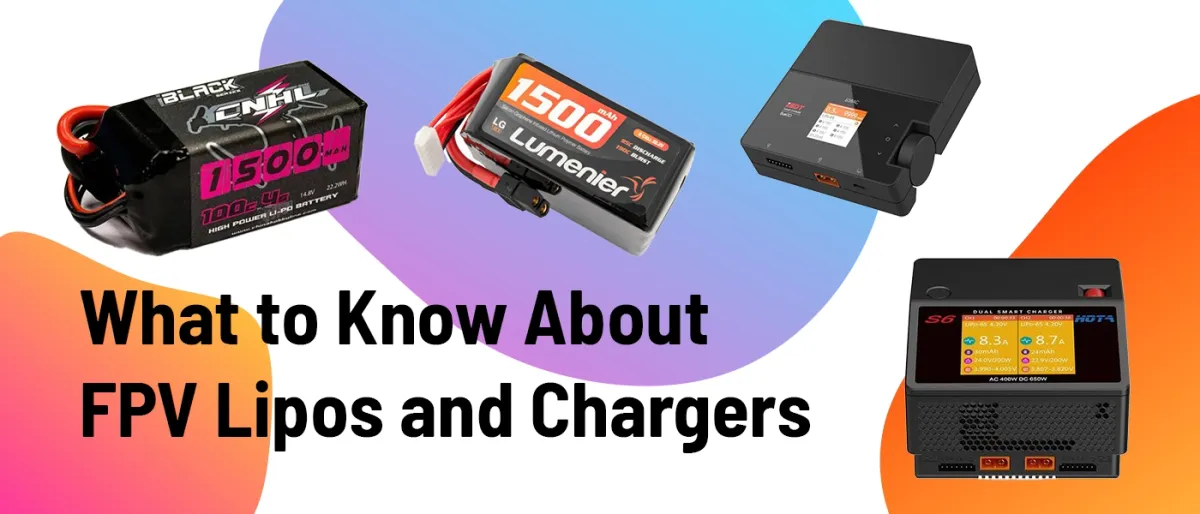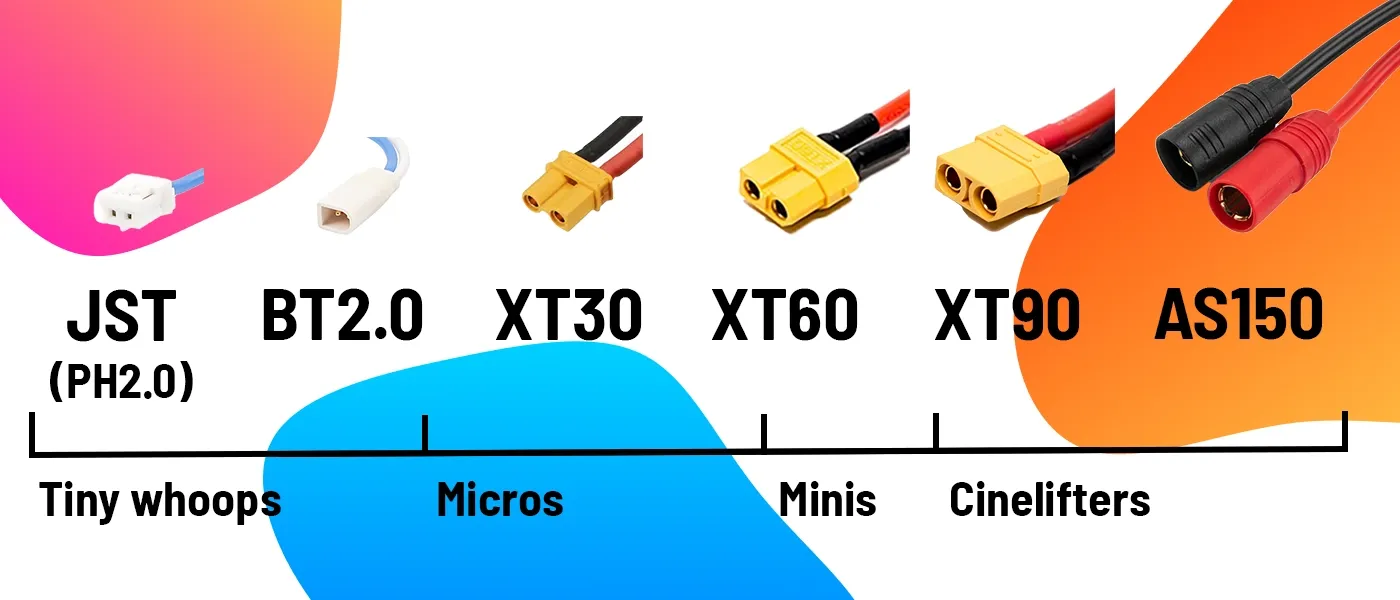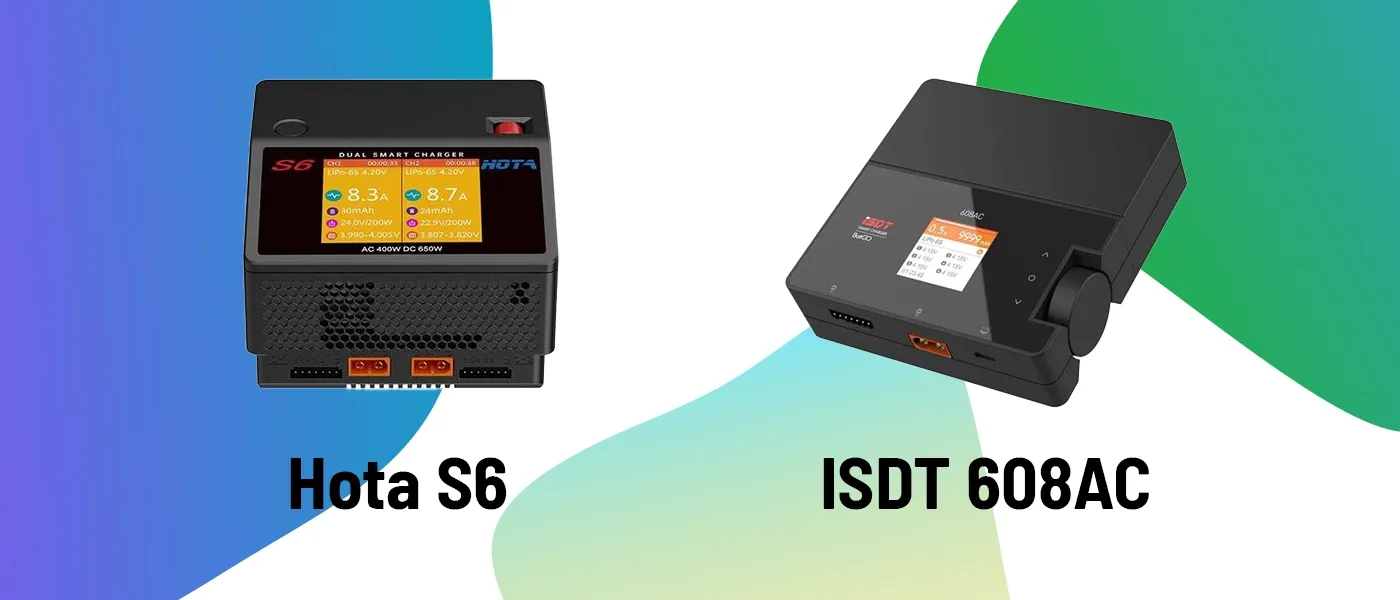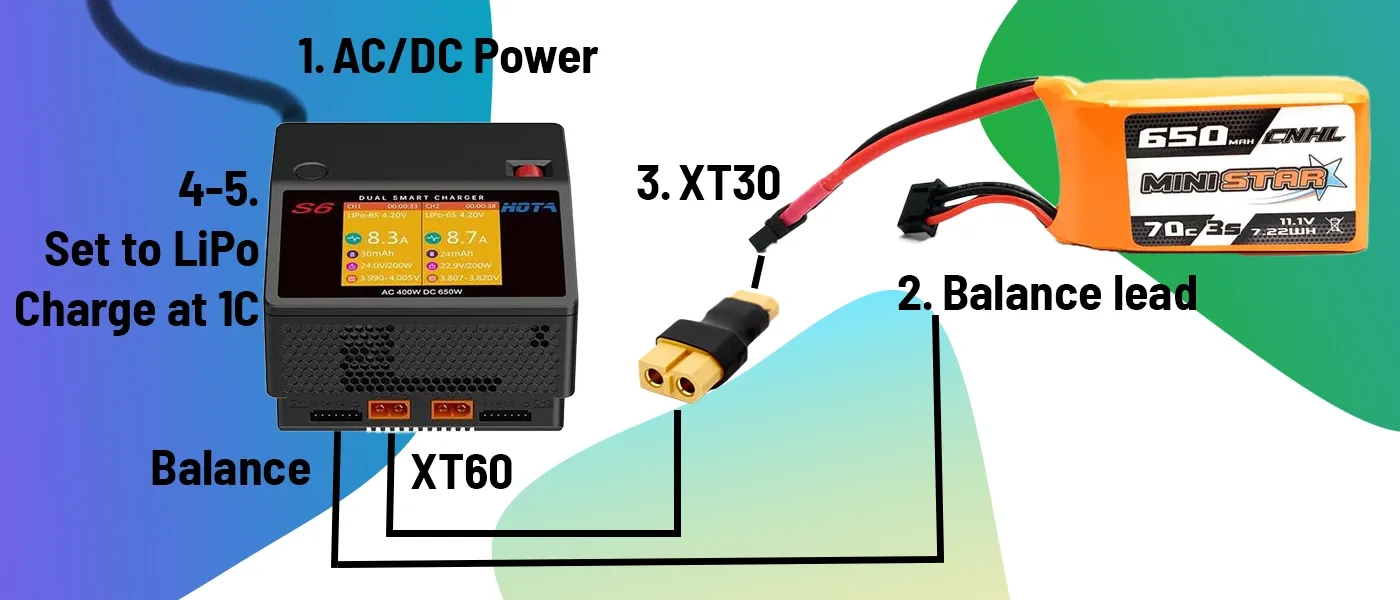Everything to Know About FPV LiPo Batteries and Chargers
We breakdown everything you need to know about FPV batteries and chargers, and how to choose the right one for you. Charging and maintaining LiPos is not as simple as plugging your laptop in. We'll bring you up to speed on all things LiPos.

What are Lipo Batteries
Lithium Polymer (LiPo) batteries are a type of rechargeable battery widely used in FPV drones. LiPo batteries are lightweight and compact, making them ideal for use in FPV drones. They also have high energy density, which means they can store a lot of energy in a small package.
LiPo batteries provide power to the motors and other electronics, like the flight controller, video transmitter, and FPV camera. LiPo batteries are typically rated by their voltage, capacity, and discharge rate which determine how long the battery can provide power to the drone and how quickly it can discharge its energy.
It's important to choose LiPo batteries that are compatible with your FPV drone and to use them properly to ensure that they last as long as possible. LiPo batteries should be stored in a safe place, charged properly, and never over-discharged, as over-discharging can cause damage to the battery and reduce its lifespan. Jump down to read more about LiPo charging and storage.
How to Choose Lipo Batteries for your FPV drone
Capacity
The capacity of a battery, measured in milliampere-hours (mAh), determines how long the battery will last before it needs to be recharged. For FPV drones, you will want a battery with a high capacity to ensure that you have enough power for your flight.
Voltage / Cells
The voltage of a LiPo, measured in volts (V), determines the power output of the battery. Every LiPo cell has a nominal voltage of 3.7V. LiPo batteries for FPV typically use 1 or more cells.
| Lipo Voltage Table | ||||||
|---|---|---|---|---|---|---|
| Cell Count | 1S | 2S | 3S | 4S | 5S | 6S |
| Nominal Voltage | 3.7V | 7.4V | 11.1V | 14.8V | 18.5V | 22.2V |
| Fully-charged Voltage | 4.2V | 8.4V | 12.6V | 16.8V | 21V | 25.2V |
Typical LiPo capacity by frame size and LiPo cell count
Use this table as a starting point for choosing the right LiPo capacity and cell count for your next build.
| Quad type | Quad size | Capacity | Cells |
|---|---|---|---|
| Tiny whoop | Smaller than 2" | 300 - 450 mAh | 1S, 2S, 3S |
| Micro freestyle and whoops | Between 2" and 2.5" | 300 - 450 mAh | 2S, 3S |
| Micro freestyle and whoops | Between 2" and 2.5" | 450 - 650 mAh | 4S |
| Freestyle and racing | Between 2" and 2.5" | 300 mAh | 2S |
| Freestyle and racing | Between 2" and 2.5" | 650 mAh | 3S |
| Freestyle and racing | Between 2" and 2.5" | 450 - 850 mAh | 4S |
| Freestyle and racing | Between 3" and 4" | 450 - 850 mAh | 2S |
| Freestyle and racing | Between 3" and 4" | 550 - 850 mAh | 3S |
| Freestyle and racing | Between 3" and 4" | 450 - 1000 mAh | 4S |
| Freestyle and racing | Between 3" and 4" | 550 - 650 mAh | 6S |
| Cinewhoop | Between 3" and 3.5" | 850 - 1300 mAh | 4S |
| Cinewhoop | Between 3" and 3.5" | 600 - 850 mAh | 6S |
| Cinewhoop | Between 3.5" and 4" | 1100 - 1800 mAh | 4S, 6S |
| Freestyle and racing | Between 4" and 5" | 850 - 1000 mAh | 4S |
| Freestyle and racing | Between 4" and 5" | 650 - 850 mAh | 6S |
| Freestyle and racing | Between 5" and 6" | 1300 - 1500 mAh | 4S |
| Freestyle and racing | Between 5" and 6" | 1000 - 1300 mAh | 6S |
| Freestyle and racing | Between 6" and 7" | 1300 - 1800 mAh | 4S |
| Freestyle and racing | Between 6" and 7" | 1000 - 1500 mAh | 6S |
Shop 1S LiPo batteries for FPV
Shop 2S LiPo batteries for FPV
Shop 3S LiPo batteries for FPV
Shop 4S LiPo batteries for FPV
Shop 5S LiPo batteries for FPV
Shop 6S LiPo batteries for FPV
Connector

Ensure that the battery you choose has the right type of connector for your quad. If you're building a quad, follow the guidelines below to choose which battery connector and pigtail you need for your build.
The most popular connectors for tiny whoops are JST/PH2.0 which are rated to handle up to 2 amps of continuous current, and BT2.0 which can handle up to 9A of continuous current.
For micro quads, the most popular connectors are XT30 and XT60 which are rated to handle 30A and 60A of continuous current respectively.
For mini quads, the most popular connector is the XT60.
For cinelifters and larger quads with heavy payloads, popular connectors are the XT90 and AS150.
If you're debating between a build with an XT30 or XT60 connector, a safe and easy way to choose is knowing your ESC's current rating. If it's less than 30A, get the XT30 connector. If it's more than 30A, get the XT60 connector.
If you're not sure how much current your quad needs to sustain, read more about how to choose your quad's powertrain parts here.
Weight
The weight of a battery is another consideration for FPV drones, as weight can affect the overall power balance of the drone. Bigger doesn't always mean better. The larger the LiPo capacity, the heavier the battery will be. Because of this, your quad will need more power to carry the extra weight.
Use the table above as a starting point to choose a LiPo capacity right for your build. Then compare the weight of LiPos of the same and different capacities. Some batteries that have the same cell count and capacity can weigh differently from each other.
Brand and reputation
It's also important to consider the brand and reputation of the battery manufacturer. Reputable manufacturers have a good track record of producing high-quality and reliable batteries.
Shop top tier brands include Lumenier and Tattu.
And shop other reputable brands include CHNL and Gaoneng (including RDQ Series).
Discharge rate
While we mentioned discharge rate affects how much power the quad can draw, brands typically inflate their discharge rate number. Testing by the community has shown that most brands' LiPos discharge between 40C and 50C.
High Voltage LiPo Batteries for FPV
High voltage LiPo batteries (LiHV) are very similar to the LiPo batteries we just described. LiHVs have the same chemistry has LiPos, but the difference is that they can be charged to 4.35V per cell vs 4.2V for normal LiPos.
The advantages of a LiHV battery vs a LiPo battery is that because the battery runs at a higher voltage, the quad's motors should see slight performance boost when compared to a LiPo of the same capacity and cell count. And because they maintain a higher voltage, they are able to store more energy with the same amount of weight resulting in slightly higher flight times.
Another consideration when choosing whether to use LiHV batteries is if your charger has the functionality to charge them to 4.35V. Some chargers have presets for LiHV batteries, others allow you to set your charge to 4.35V, while other chargers do not support LiHV batteries.
You can charge LiHV batteries to 4.2V, but you wouldn't be taking advantage of higher voltage. It's also worth noting that LiHV batteries are slightly more expensive that their LiPo counterparts. If you need the extra performance, you should certainly consider them. For beginners, stick to LiPos, but think about whether you want to have the capability to charge LiHV batteries when choosing your charger.
Shop LiHV batteries on QuadPartPicker.
Lithium Ion Batteries for FPV
Some pilots opt to power their quads with lithium ion (Li-ion) batteries over LiPo batteries. In most cases, they are using Li-ion batteries for ultra-light builds designs for long distance flight.
Lithium ion batteries are heavier and have a much lower discharge rate compared to LiPos making them less ideal for freestyle and racing. However, they are great for long-range cruising. Lithium ion batteries also have a longer lifespan than LiPos and are typically safer because they are less prone to overcharging and over-discharging.
Shop Lithium ion batteries on QuadPartPicker.
Charging and Storing LiPo Batteries
LiPo batteries, due to their lightweight and high-discharge rates, are also their vulnerability. Unlike charging the smart batteries that come with DJI drones, LiPos aren't protected with an outer shell, and they don't automatically discharge to a safe storage voltage.
LiPo batteries are generally very safe when used and stored properly. However, when they aren't, LiPos are more susceptible to catching fire. LiPo fires are especially dangerous because water and normal fire retardant in fire extinguishers are less effective at putting these fires out. Fires are most likely to start when charging and discharging. Always stay within distance and keep an eye on your LiPos when charging them.
When your batteries are properly inspected, charged, and stored, your chances of a fire happening are very low.
What LiPo Charger is Right For You?
There are a few considerations to think about when deciding on the right LiPo charger for you. Below, we have two recommendations.
When buying a charger, think about how you'll likely be using it. If you plan on charging all your batteries at home, you won't need something portable enough bring with you. Some chargers can charge more than 1 battery safely at a time. Others require a separate AC power supply to power the charger.
QuadPartPicker's LiPo Charger Recommendations
There are two highly-rated chargers that are excellent for FPV pilots. They come from reputable brands and have been used by the community for years with solid reviews. These are:

Both of these chargers come with AC power, so you won't need an additional power supply like some other LiPo chargers. Both of these are also compatible with LiHV batteries.
The main difference between the two is how quickly you can get flying again. The Hota S6 can charge two batteries at the same time and has a higher, 400W AC power supply, while the 608AC comes with a 60W AC power supply. This means that with the 608AC, you're limited to slower and single-battery charging.
If you decide to get these, note that they use an XT60 connector. You can get a XT30 to XT60 connector here.
Shop all LiPo chargers on QuadPartPicker.
How To Charge LiPo Batteries
No matter which charger you buy, charging your battery typically follows the same steps.
- Power your charger, whether with AC power plugged into a power socket, or DC power through a LiPo battery pack.
- Plug your battery's balance lead, the smaller plug, into the charger. The charger should display the voltage of each cell in your LiPo pack and they should all be about the same voltage.
- Plug the XT60 battery (or XT30 battery with a XT30 to XT60 connector) into the XT60 port next to the balance lead port you just plugged in.
- In the settings of your charger, ensure that you have the right battery chemistry set (LiPo).
- In the charger's settings menu, set your charge rate to 1C. You may have to manually set this depending on what your battery's capacity is. For example, if you have a 1500 mAh LiPo, set your charge rate 1.5A. If you have a 500 mAh Lipo, set your charge rate to 0.5A. Similarily, if you have a 2000 mAh LiPo, set your charge rage to 2A. Doing this ensures you're charging safely.

When charging your high voltage LiPo batteries, first ensure that your charger has the function available. Then follow the same steps above, except set the battery chemistry to LiHV if available, or set your max charge to 4.35V instead of 4.2V.
How to store LiPo batteries
After discharging your batteries, always charge them back to storage voltage (3.8V). If you plan on using them again immediately or within a few days, you can charge your LiPos to full voltage (4.2V). However avoid leaving them at full voltage for too long as your battery will degrade faster.
If you aren't planning on using your fully-charged batteries, ensure they're in storage voltage (3.8V) and depending on your risk tolerance from low to high, put your batteries in a safe container like:
A LiPo-safe bag, which will not contain a fire, but provide slight protection.
A Bat-Safe Box, one of the most popular products for LiPo battery storage.
A ammo box with the gaskets taken out can contain a fire.
Any of the above with a bag of sand on top. If a fire starts, the fire breaks the bag holding the sand and dumps it on the fire.
No matter what the container, ensure that your batteries are stored in a cool and dry setting that's not extremely hot or cold, ideally between 68-75°F (20-25°C), and away from flammable materials. Store LiPo batteries in a location where they cannot be knocked over or damaged, and where they will not come into contact with other materials that could cause a fire.
Parallel charging
Parallel charging is a method of charging multiple LiPo batteries at the same time using a single charger. With this method, the positive terminals of the batteries are connected together, and the negative terminals are connected together on a parallel charging board. This allows all the batteries to be charged at the same time, which can save time and improve efficiency. There are precautions to take so it's not as simple as plugging in a parallel charging board.
We're dedicating an entire issue to parallel charging coming soon.
It might seem like a lot to just maintain your LiPo batteries, but doing so ensures that your batteries will last as long as possible.
Shop All LiPo Batteries on QuadPartPicker.
